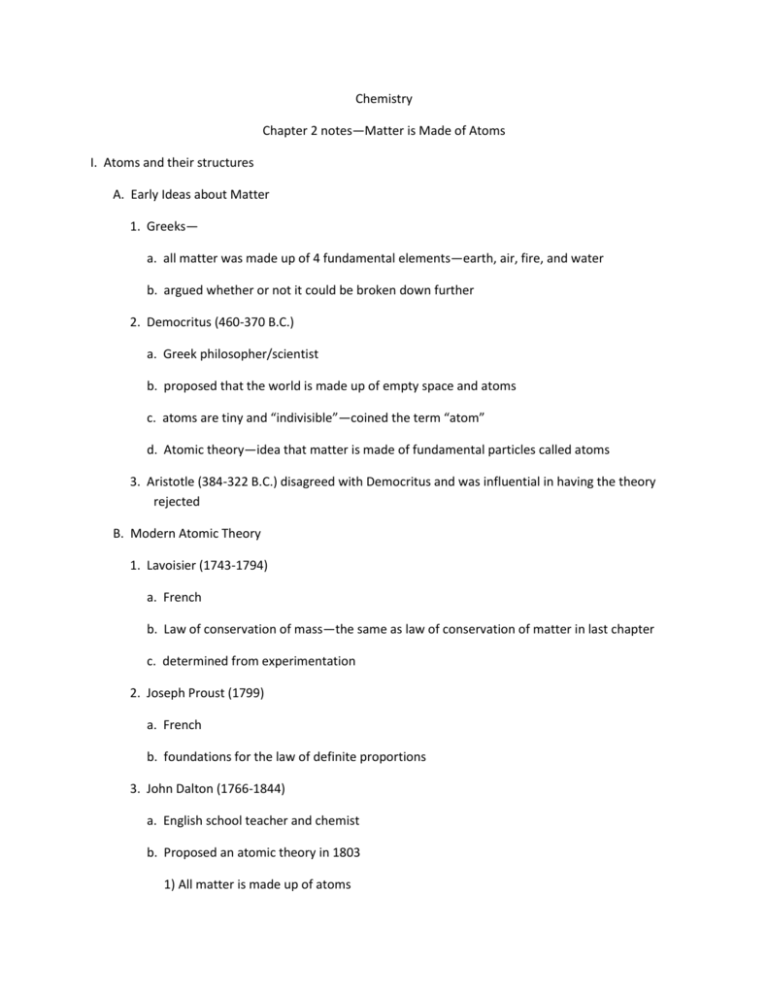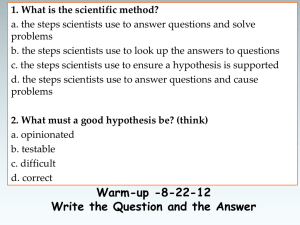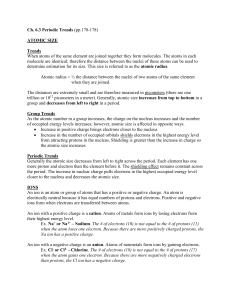Chapter 2 - Hope Charter School
advertisement

Chemistry Chapter 2 notes—Matter is Made of Atoms I. Atoms and their structures A. Early Ideas about Matter 1. Greeks— a. all matter was made up of 4 fundamental elements—earth, air, fire, and water b. argued whether or not it could be broken down further 2. Democritus (460-370 B.C.) a. Greek philosopher/scientist b. proposed that the world is made up of empty space and atoms c. atoms are tiny and “indivisible”—coined the term “atom” d. Atomic theory—idea that matter is made of fundamental particles called atoms 3. Aristotle (384-322 B.C.) disagreed with Democritus and was influential in having the theory rejected B. Modern Atomic Theory 1. Lavoisier (1743-1794) a. French b. Law of conservation of mass—the same as law of conservation of matter in last chapter c. determined from experimentation 2. Joseph Proust (1799) a. French b. foundations for the law of definite proportions 3. John Dalton (1766-1844) a. English school teacher and chemist b. Proposed an atomic theory in 1803 1) All matter is made up of atoms 2) Atoms are indivisible 3) All atoms of one element are exactly alike, but different from atoms of other elements. 4. JJ Thomson (1897) a. British physicist b. Plum-pudding model c. Practically speaking discovered electrons in the atom 5. Nagaoka (1897ish) a. Japanese physicist b. Proposed positively charged nucleus w/electrons orbiting 6. Rutherford (1909) a. British b. Experimented and gave support to a positive nucleus c. Practically gave us the proton 7. Chadwick (1932) a. British b. Discovered the neutron in the nucleus 8. Bohr (1913) a. Danish b. Worked with Rutherford c. Planetary model—electrons orbit the nucleus in certain energy levels d. He gave us Electron Energy Levels 9. Heisenberg (1920s) a. German b. Heisenberg Uncertainty Principle—we are uncertain of where an electron is (shortened version) 10. Quantum mechanics a. Quantum theory b. Electron cloud c. Orbitals II. Atomic theory, conservation of matter, and recycling A. Matter is reused and not created or destroyed B. Recycling imitates nature III. Hypotheses, Theories, and Laws A. Hypothesis 1. An educated guess 2. An idea with possibly some support B. Theory 1. An idea with supporting evidence and little or none against 2. It may be modified or Revised C. Law 1. An idea with lots of supporting evidence and none against 2. If new evidence arises that goes against, the evidence is verified and if found true, the law becomes a theory. D. Experimentation 1. Method to collect evidence for theories and laws 2. Scientific Method—already discussed IV. Atomic Structure A. Nuclear Atom 1. Protons a. charged positively b. mass = 1.67 x 10-24g 2. Neutrons a. no electrical charge—neutral b. mass = 1.67 x 10-24g plus a little more 3. Atomic Number a. number of protons in the atom b. determines which element an atom belongs to 4. Mass Number a. number of protons and neutrons in the atom b. number of particles contributing to the mass of the atom 5. Atomic Mass a. mass of the nucleus, which is considered the mass of the atom b. electrons are insignificant c. measured in atomic mass units or Daltons 1) 1 amu = 1 u = 1 d = 1/12 the mass of a C-12 atom 2) practically 1 amu = the mass of a proton or neutron 3) periodic table and normal usage uses the average value of all naturally occurring isotopes 6. Isotopes a. Elements with the same number of protons, but different number of neutrons b. notation p. 65 and use the board to demonstrate B. Electrons 1. Energy allows them to orbit, instead of collapsing (hypothesis) 2. Electromagnetic Spectrum a. Electromagnetic radiation—radiant energy b. Travels as electromagnetic waves 1) Electric and magnetic properties 2) can travel through a vacuum 3) speed—300 million m/s c. Properties 1) Frequency a) number of vibrations per second b) Unit is the hertz (Hz) 2) Wavelength a) distance from one crest to the next b) low frequency results in long wavelength and vice versa d. Forms a. Radio, Microwaves, Infrared, Visible light, UV, X-rays, Gamma rays b. Visible light (ROY G BIV)—red, orange, yellow, green, blue, indigo, violet 3. Electrons and Light a. As electrons gain energy they jump to a higher level (quantize) b. As they release the energy they give off light and drop back down—this emission spectrum is unique for an element or compound c. Bohr’s model accounts for these specific energy levels 1) as we go higher up there is less energy difference 2) similar to rungs on a ladder d. Electron cloud—actually the levels are more like clouds, then lines 1) basis for the quantum theory 2) cloud is actually called an orbital—an area of high probability of finding an electron 4. Electrons in energy levels a. Valence level 1) Outer level 2) Octet Rule—can hold a maximum of 8 electrons b. Electron levels are given the algebraic letter designation of n c. Each level has a limit to the number it can hold (2n2) refer to table by Hill d. electrons in the outer level are known as valence electrons 5. Lewis structures











